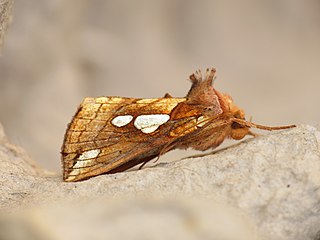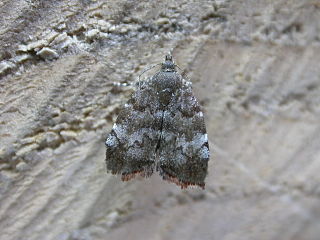
Schinia, commonly called flower moths, is a large genus of moths belonging to the family Noctuidae. The genus has a Holarctic distribution with the vast majority of species being found in North America, many with a very restricted range and larval food plant.

Yponomeutinae is a subfamily of "micromoths" in the lepidopteran family Yponomeutidae. As their scientific name implies, this is the subfamily containing the type genus of the ermine moths, Yponomeuta. The subfamily has worldwide distribution.
Fauna Europaea is a database of the scientific names and distribution of all living multicellular European land and fresh-water animals. It serves as a standard taxonomic source for animal taxonomy within the Pan-European Species directories Infrastructure (PESI). As of June 2020, Fauna Europaea reported that their database contained 235,708 taxon names and 173,654 species names.

Megacraspedus is a genus of moths in the family Gelechiidae, found primarily in the Palearctic.

Notiophilus biguttatus is a species of ground beetle native to the Palearctic. It was first described by Johan Christian Fabricius in 1779. Sometimes referred to as the Common springtail stalker

Plusia putnami, the Lempke's gold spot or Putnam's looper moth, is a species of moth of the family Noctuidae. It is found in the Palearctic realm, from Japan and eastern Siberia to Fennoscandia, Great Britain, and France. In North America, it ranges from Newfoundland and Labrador to central Alaska and the interior of British Columbia, south to Pennsylvania, Washington, north-eastern California, and in the Rocky Mountains to Utah and Colorado.

Euxoa conspicua is a moth of the family Noctuidae. It is found in Portugal, Spain, Andorra, France, Italy, Corsica, Crete, Cyprus, Romania, Bulgaria, Greece, Ukraine and southern and eastern Russia, east to China and northern India. It is also present in the Levant.

Epinotia nisella is a moth of the family Tortricidae which is found in the Palearctic, Europe and North America. It was first described by Carl Alexander Clerck in 1759.

Parornix betulae is a moth of the family Gracillariidae. It is known from all of Europe, east to Korea. It was recently reported from Canada, with records from Québec, Ontario and British Columbia.

Caloptilia suberinella is a moth of the family Gracillariidae. It is known from the Netherlands, Sweden, Norway, Finland, Denmark, Germany, Switzerland, Poland, Latvia, Estonia, Ukraine, Russia and China. It was recently recorded from North America.

Tropinota squalida is a species of beetle belonging to the family Scarabaeidae, subfamily Cetoniinae.

Choreutis pariana, the apple-and-thorn skeletonizer or apple leaf skeletonizer, is a moth of the family Choreutidae. The moth was first described by the Swedish entomologist Carl Alexander Clerck in 1759. It is native to Eurasia and was introduced to New England, USA in 1917.

Coleophora granulatella is a moth of the family Coleophoridae. It is known from most of Europe to China. It was recently reported from North America, with records from Alberta, British Columbia, Yukon, Arizona, Colorado, Michigan, Wyoming and Washington.

Hellinsia pectodactylus is a species of moth in the family Pterophoridae. It is found in Europe, the Canary Islands, Kyrgyzstan, Afghanistan, India and North America.

Pterolonche inspersa, sometimes called the brown-winged knapweed root moth, is a small moth of the family Pterolonchidae.

Nemophora bellela is a moth of the Adelidae family. It is the only circumpolar species of the Nemophora, and the only representative of the genus in North America, where it is found from Quebec across Canada north of the plains to the mountains of British Columbia and Alaska.

Lamoria anella is a species of snout moth described by Michael Denis and Ignaz Schiffermüller in 1775 found in Africa, Asia and Europe.

Cedestis subfasciella is a moth of the family Yponomeutidae. It is found in almost all of Europe, except part of the Balkan Peninsula.
Megacraspedus squalida is a moth of the family Gelechiidae. It was described by Edward Meyrick in 1926. It is found in Spain.

Actebia balanitis is a moth of the family Noctuidae first described by Augustus Radcliffe Grote in 1873. It is found from north-east Alaska and western Yukon east to east central Saskatchewan and north central South Dakota, south to northern Colorado and west to central Washington and the dry interior of British Columbia. The wingspan is 36–40 mm. Adults are on wing from June to August depending on the location. There is one generation per year.

















